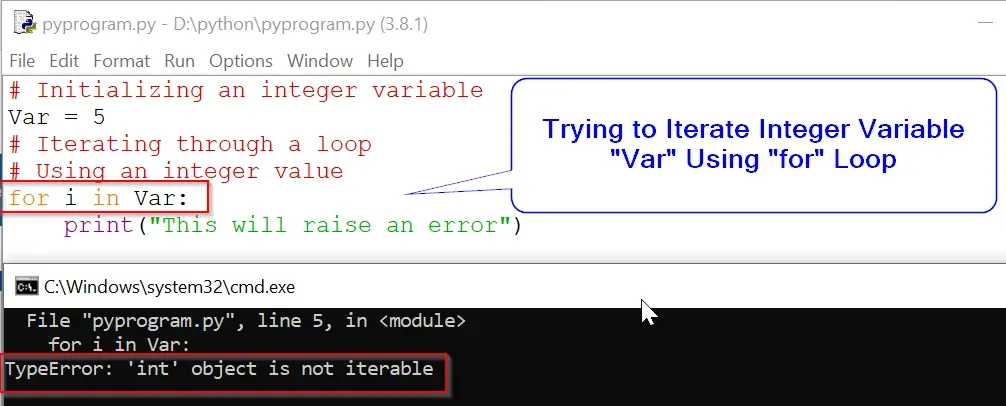Typeerror: ‘Nonetype’ Object Is Not Iterable
In programming, errors are common and can often lead to frustration and confusion. One such error is the “TypeError: ‘NoneType’ object is not iterable.” This error typically occurs when you try to iterate over an object that is of type ‘None’. In this article, we will explore what a TypeError is, what a ‘NoneType’ object is, the concept of iterability, common causes of this error, and how to fix it. We will also provide some best practices to avoid encountering this error in your code.
What is a TypeError?
In Python, a TypeError is a type of exception that occurs when an operation is performed on an object of an inappropriate type. These errors are raised when there is a mismatch between the expected type of an object and the actual type of the object being used. A TypeError can occur in various scenarios, such as when you try to perform arithmetic operations on incompatible types or when you try to call a method on an object that does not support that operation.
What does it mean for an object to be iterable?
In programming, an object is said to be iterable if it can be looped over or if it can be used in iterations, such as in a for loop. Iterable objects in Python include strings, lists, tuples, dictionaries, and more. These objects can be accessed item by item, allowing you to perform operations on each item individually.
Common causes of ‘TypeError: ‘NoneType’ object is not iterable’
1. Assigning ‘None’ to a variable: If you assign the value ‘None’ to a variable and then try to iterate over it, you will encounter this error. ‘None’ is a special value in Python that represents the absence of a value.
2. Forgetting to return a value from a function: If a function does not have a return statement or if the return statement is not reached, the function will return ‘None’ by default. If you try to iterate over the return value of such a function, you will encounter this error.
3. Incorrect function call: If you mistakenly call a function that is supposed to return an iterable object, but it instead returns ‘None’, you will encounter this error.
How to fix a ‘TypeError: ‘NoneType’ object is not iterable’ error?
1. Check for ‘None’ in your code: Search for places in your code where you assign the value ‘None’ to a variable or where a function might return ‘None’. Make sure to handle these cases properly.
2. Add conditional checks: Implement conditional checks to ensure that you only iterate over objects that are not ‘None’. For example, you can use an ‘if’ statement to check if an object is not ‘None’ before performing any iterable operations.
3. Review function calls: Double-check the functions that you call to ensure they return iterable objects. If necessary, modify the functions to return the expected iterable object.
Best practices to avoid a ‘TypeError: ‘NoneType’ object is not iterable’ error
1. Use proper variable initialization: It is good practice to initialize your variables with an appropriate value, other than ‘None’, before using them in your code.
2. Use type hints: Utilize type hints in your code to explicitly specify the expected type of a variable or return value. This can help catch potential type errors early on and make your code more robust.
3. Test your code thoroughly: Write comprehensive test cases to verify the behavior of your code, including handling cases where ‘None’ might be encountered.
4. Follow the PEP 8 style guide: Adhering to the Python style guide can make your code more readable and reduce the chances of introducing errors. Consistent code formatting can also help prevent mistakes related to ‘NoneType’ errors.
FAQs
Q: What does “nonetype” mean in a ‘TypeError’?
A: ‘Nonetype’ refers to the type of the ‘None’ object in Python. It is a special type that represents the absence of a value.
Q: Can an ‘object’ be non-iterable?
A: Yes, an object can be non-iterable if it does not support the iteration protocol. This means that it cannot be used in iterations such as for loops or list comprehensions.
Q: How can I handle ‘NoneType’ objects in JavaScript or Django?
A: In JavaScript, you can use conditional checks or fallback values to handle ‘NoneType’ objects. In Django, you can use the ‘if’ template tag or the ‘none’ filter to handle these objects in your templates.
Q: How do I deal with ‘NoneType’ in Python?
A: To deal with ‘NoneType’ objects in Python, you can check for ‘None’ using conditional statements, validate input values, and handle specific cases where ‘None’ might be encountered.
Q: How do I handle a ‘TypeError’ when a Queue object is not iterable?
A: If you encounter a ‘TypeError’ when a Queue object is not iterable, you can try converting it to a list or using the ‘get’ method to retrieve items from the queue one by one.
In conclusion, the ‘TypeError: ‘NoneType’ object is not iterable’ error can often be resolved by carefully reviewing your code and handling cases where ‘None’ might be encountered. By implementing the suggested solutions and following the best practices outlined in this article, you can minimize the occurrence of this error and build more robust and error-free programs.
Python Typeerror: ‘Nonetype’ Object Is Not Iterable
Why Is My Object Not Iterable?
If you have ever encountered the error message “object is not iterable,” you may have found yourself confused and frustrated. This is a common error in programming, particularly in languages like Python, that use iterable objects heavily.
Being iterable means that an object can be looped over, which is often crucial in programming to perform repetitive tasks. This error occurs when you try to use a loop or iterate over an object that does not support iteration. In this article, we will explore the reasons behind this error and how to fix it.
1. Understanding Iterables and Iterators:
Before diving into the reasons an object may not be iterable, it is essential to understand the concept of iterables and iterators. An iterable is any object that can be looped over, such as a list, tuple, or string. Iterators, on the other hand, are objects used to iterate over iterables, enabling sequential access to their elements.
2. Common Reasons for “object is not iterable” Errors:
2.1 Incorrect Object Type:
One frequent reason for this error is attempting to iterate over an object that is not iterable in the first place. For example, trying to loop over an integer, boolean, or None value will result in an “object is not iterable” error. Ensure that you are using a proper iterable object before attempting to iterate over it.
2.2 Forgotten __iter__() or __getitem__() Methods:
To enable iteration on an object, it must have either the __iter__() method or the __getitem__() method defined. These methods allow the object to behave as an iterator or provide an iterator when needed. If an object lacks these crucial methods, attempting to iterate over it will throw an “object is not iterable” error. Make sure the object you are trying to iterate over has the necessary methods defined.
2.3 Exhausted or Non-Rewindable Iterators:
Some iterable objects, like file objects, can only be iterated over once. Once the iterator has reached the end, it becomes exhausted and cannot be iterated over again. If you try to iterate over an already exhausted iterator, you will encounter the “object is not iterable” error. To overcome this, reopen the file or recreate the iterator if you need to iterate over it multiple times.
3. Ways to Make an Object Iterable:
If you encounter the “object is not iterable” error and determine that the object should be iterable, there are several ways to resolve the issue:
3.1 Implement __iter__() or __getitem__() Methods:
As mentioned earlier, implementing the __iter__() or __getitem__() methods is necessary for an object to support iteration. By defining these methods, you can customize the behavior of your object during iteration. Ensure that the __iter__() method returns the iterator object itself.
3.2 Use Built-in Iteration Tools:
Python provides several built-in iteration tools that can help make an object iterable. For instance, the iter() function can convert an iterable object into an iterator. Additionally, the itertools module offers various functions, such as count(), cycle(), and repeat(), that can be used to create custom iterators.
3.3 Convert to an Iterable Object:
If the object you are dealing with is not inherently iterable, you can convert it to an iterable object. For example, you can convert a string to a list using the list() function and then iterate over it. This approach often requires transforming the object into a suitable iterable form before looping over it.
FAQs:
Q1. Can I iterate over a dictionary?
A1. Yes, dictionaries in Python are iterable, but they are iterable over their keys by default. If you need to iterate over both keys and values, you can use the items() method: `for key, value in my_dict.items():`.
Q2. How can I check if an object is iterable?
A2. To test if an object is iterable, you can use the isinstance() function along with the collections.abc module. Import the Iterable class from the module and use `isinstance(my_object, Iterable)` to check if it is iterable.
Q3. What is the difference between an iterable and an iterator?
A3. An iterable is any object that can be looped over, while an iterator is an object used to iterate over an iterable by providing sequential access to its elements. Iterators maintain state and fetch the next element using the `__next__()` method.
Q4. Why is it important to check if an object is iterable before iterating over it?
A4. Checking if an object is iterable before attempting to iterate over it helps prevent errors and ensures the code runs smoothly. It allows you to handle non-iterable objects differently, avoiding unnecessary iterations or potential errors.
In conclusion, encountering the “object is not iterable” error is common when attempting to iterate over an object that does not support iteration. This article explored the reasons behind this error and provided solutions to make an object iterable. By understanding iterables, iterators, and implementing the necessary methods, you can overcome this error and successfully loop over objects in your code.
How To Iterate Nonetype Object In Python?
Python is a versatile programming language known for its simplicity and readability. Like any other programming language, Python has its own unique set of data types, one of which is the NoneType object. NoneType is a special data type in Python used to represent the absence of any value or an undefined value. It is often used as a default return type of functions that do not explicitly return a value.
In many cases, you might encounter situations where you need to iterate over a NoneType object in your code. However, iterating over a NoneType object can lead to unexpected errors if not handled correctly. In this article, we will explore ways to iterate over a NoneType object in Python and discuss best practices to avoid potential errors.
Iterating over a NoneType object:
When attempting to iterate over a NoneType object, Python will raise a TypeError. This is because NoneType does not support iteration since it is not considered an iterable data type. You might encounter this error if you mistakenly assign the value None to a variable that is intended to hold an iterable object, such as a list or a dictionary.
Here is an example that shows how trying to iterate over a NoneType object will result in a TypeError:
“`
my_var = None
for element in my_var:
# do something
“`
Output:
“`
TypeError: ‘NoneType’ object is not iterable
“`
Handling NoneType objects during iteration:
To iterate over a NoneType object without encountering any errors, you need to ensure that the object is iterable. There are a couple of approaches to handle NoneType objects during iteration:
1. Check for None before iteration:
One simple way to avoid errors when iterating over a NoneType object is to check if the object is None before performing any iteration. By doing this, you can prevent the code from attempting to iterate over a NoneType object.
Here is an example that demonstrates this approach:
“`python
my_var = None
if my_var is not None:
for element in my_var:
# do something
else:
print(“The object is None.”)
“`
Output:
“`
The object is None.
“`
By checking for None before iteration, you can gracefully handle situations where a NoneType object is encountered.
2. Set a default value for the NoneType object:
Another approach is to set a default value for the NoneType object, such as an empty list or an empty dictionary. This allows you to iterate over the default value without raising any errors.
Here is an example that demonstrates this approach:
“`python
my_var = None
my_var = my_var or []
for element in my_var:
# do something
“`
In this example, if the original value of my_var is None, it will be replaced with an empty list. This ensures that the code doesn’t attempt to iterate over a NoneType object.
Frequently Asked Questions:
Q: Why do I get a TypeError when trying to iterate over a NoneType object?
A: NoneType objects are not iterable in Python, which means they do not support iteration. Trying to iterate over a NoneType object will result in a TypeError.
Q: How can I check if an object is of NoneType?
A: You can use the `is` operator to check if an object is None. For example: `if my_var is None:`.
Q: What are some common scenarios where a NoneType object is encountered?
A: NoneType objects are commonly encountered when dealing with functions that do not explicitly return a value. They are often used to represent the absence of any value.
Q: Can I perform any operations on a NoneType object?
A: While NoneType objects do not support iteration or many other operations, you can still perform certain actions on them, such as checking if they are None or assigning them a new value.
Q: How can I avoid encountering NoneType objects in my code?
A: To avoid encountering NoneType objects, make sure to handle different scenarios properly, such as checking for None before performing operations or assigning default values to variables that may potentially hold None.
In conclusion, iterating over a NoneType object in Python can lead to errors if not handled correctly. By checking for None before iteration or setting a default value for the NoneType object, you can gracefully handle these situations and avoid unexpected errors in your code.
Keywords searched by users: typeerror: ‘nonetype’ object is not iterable typeerror: object is not iterable, ‘nonetype’ object is not subscriptable, Typeerror nonetype object is not iterable sort list, Object is not iterable, Object is not iterable js, Object is not iterable Django, How to deal with nonetype in python, Queue object is not iterable
Categories: Top 10 Typeerror: ‘Nonetype’ Object Is Not Iterable
See more here: nhanvietluanvan.com
Typeerror: Object Is Not Iterable
Errors are a common occurrence in programming and can be frustrating to deal with, especially for beginners. One such error is the “TypeError: Object is not iterable.” In this article, we will explore this error in-depth, understanding its causes, ways to fix it, and common FAQs related to it.
What does “TypeError: Object is not iterable” mean?
When you encounter the “TypeError: Object is not iterable” in your code, it means that you are trying to iterate (loop over) an object that is not iterable. In Python, an object is considered iterable if it can be passed to the built-in iter() function to obtain an iterator. Examples of iterable objects include lists, tuples, sets, and strings.
Causes of the “TypeError: Object is not iterable” error:
1. Missing or incorrect syntax: One common cause is a typographical error, missing parentheses, or a mismatched quotation mark when defining an iterable object. Such errors prevent the code from running correctly, leading to this error.
2. Incorrect usage of methods: Sometimes, the error occurs when a non-iterable object is used with iterative methods such as ‘for’ loops, ‘in’ operator, or list comprehensions.
3. Incorrect variable assignment: The error can also occur if you accidentally assign a non-iterable object to an iterable object, which confuses the interpreter. This usually happens when you misuse variables or use the wrong data type.
How to fix the “TypeError: Object is not iterable” error:
Now that we understand the possible causes, let’s delve into some effective ways to fix this error:
1. Check your code for syntax errors: Start by carefully inspecting your code for any syntax errors, such as missing parentheses or quotation marks. These simple mistakes can lead to the error in question.
2. Verify that you are iterating over an iterable object: Ensure that you are trying to iterate over an object that is, indeed, iterable. This includes checking whether the object is a list, tuple, string, or set, as these can be iterated over without any issues. If the object is not iterable, you may need to modify your code accordingly.
3. Double-check variable assignments: Verify that you have assigned the correct data type to your variables. Sometimes, mistakenly assigning a non-iterable object to an iterable variable can result in the error. Make sure that the right objects are assigned to compatible variables.
4. Debug your iterative methods: If you are still encountering the error, check the specific line of code where the error occurs. Review any methods or statements that involve iteration and ensure that the object being used is, in fact, iterable.
5. Use try-except blocks: Enclose your code that generates the error with a try-except block to catch the error gracefully. This way, you can display a custom error message or execute alternative actions instead of abruptly halting the program.
Frequently Asked Questions (FAQs):
Q1. Can any object be made iterable in Python?
No, not every object can be made iterable in Python. The object must implement the necessary methods to support iteration, such as __iter__() and __next__(). However, most collection-based objects like lists, tuples, and sets are iterable by default.
Q2. What should I do if I am not sure whether an object is iterable?
You can use the built-in function isinstance() to check if an object is iterable. For example, isinstance(obj, Iterable) returns True if obj is iterable, and False otherwise. Import the Iterable module from collections before using it.
Q3. How can I iterate over a non-iterable object if necessary?
To iterate over a non-iterable object, you need to convert it into an iterable object using appropriate methods. For instance, you can convert a string to a list using the list() function, or use the iter() function with custom iterables.
Q4. I’m sure my object is iterable, but the error still persists. What could be the issue?
In some rare cases, if you have defined a custom iterable object, it might not be implemented correctly. Ensure the necessary methods like __iter__() and __next__() are properly implemented. Debugging your custom object’s implementation might help identify the issue.
Conclusion:
The “TypeError: Object is not iterable” error occurs when an object that is non-iterable is passed to an iterative construct. By understanding the causes and following the troubleshooting steps discussed above, you should be able to resolve this error when it appears in your code. Remember to carefully examine your code for syntax errors, verify object iterability, and validate variable assignments. By doing so, you can mitigate this error and keep your programs running smoothly.
‘Nonetype’ Object Is Not Subscriptable
Introduction:
In the world of programming, one might come across an error message stating that a ‘NoneType’ object is not subscriptable. This puzzling error can often lead to confusion and frustration for programmers, especially those who are new to the field. In this article, we will delve into the nature of ‘NoneType’ objects, explain their lack of subscriptability, and provide insights into common scenarios where this error can occur.
Understanding ‘NoneType’ Objects:
‘NoneType’ is a unique object type in Python that represents the absence of a value or a null value. It signifies the lack of any value being assigned to a variable or a function that does not explicitly return a value. It is often used in programming to indicate that something is not defined or does not exist.
The Inability to be Subscripted:
Subscripting involves accessing specific elements within an object such as a list, tuple, or dictionary, using square brackets and indices. However, attempting to subscript a ‘NoneType’ object will result in a TypeError, stating that ‘NoneType’ object is not subscriptable.
The reason behind this error lies in the inherent property of ‘NoneType’ objects. Since they do not contain any elements to be accessed, attempting to access a nonexistent element using subscripting raises an exception. It serves as a reminder for programmers to handle such cases appropriately by either initializing variables or performing necessary checks before proceeding with subscripting operations.
Scenarios Where the Error May Occur:
1. Uninitialized Variables:
If a variable is left uninitialized and holds the ‘None’ value, an attempt to subscript this variable will result in the ‘NoneType’ object not subscriptable error. Therefore, ensure that variables are correctly initialized before subscripting them.
2. Functions without Return Statements:
If a function lacks a return statement or explicitly returns ‘None’, attempting to subscript the function’s return value will raise the ‘NoneType’ object not subscriptable error. It is important to ensure that functions return the appropriate values or handle cases where ‘None’ may be returned.
3. improper Assignments:
Assigning a ‘None’ value to an incorrect object type can lead to the ‘NoneType’ object not subscriptable error. For example, assigning ‘None’ to a numeric variable, and then later trying to subscript it, will result in the error. Therefore, double-check variable assignments to avoid such issues.
FAQs:
1. How can I fix the ‘NoneType’ object not subscriptable error?
To fix the error, it is crucial to determine the root cause. Ensure that variables are correctly initialized, functions return the expected values, and assignments are made correctly. Implement proper checks and conditionals to handle scenarios where ‘None’ is an expected return value.
2. Why do I encounter this error when handling APIs or database queries?
When working with external services like APIs or databases, it is common to receive ‘None’ as a response when the requested data is not found. If proper checks or error handling mechanisms are not in place, attempting to subscript the received ‘None’ value may raise the error. Always verify the response before performing any subscripting operations.
3. Can I make a ‘NoneType’ object subscriptable?
No, it is not possible to make a ‘NoneType’ object subscriptable. The nature of ‘NoneType’ objects makes them incompatible with subscripting, as they lack elements or indices to access.
4. Is the ‘NoneType’ object not subscriptable error specific to Python?
The ‘NoneType’ object not subscriptable error is specific to Python. Other programming languages may have similar concepts, but their error messages and behavior may vary.
Conclusion:
Understanding the ‘NoneType’ object not subscriptable error is crucial for any Python programmer. By grasping the nature of ‘NoneType’ objects and their limitations in subscripting, developers can resolve this error effectively. Be diligent when initializing variables, handling return values, and performing assignments to minimize encountering the ‘NoneType’ object not subscriptable error and optimize your code for a smooth execution.
Typeerror Nonetype Object Is Not Iterable Sort List
When working with lists in Python, it is common to encounter various errors. One such error is the TypeError: ‘NoneType’ object is not iterable. This error occurs when attempting to sort a list that contains None values. In this article, we will delve into the details of this error, understand its causes, and explore how to solve it effectively.
Understanding the TypeError: ‘NoneType’ object is not iterable
The TypeError: ‘NoneType’ object is not iterable occurs when we try to iterate over an object that has a None value. In Python, None is a special constant that represents the absence of a value or a null value. It is often used to indicate that a variable or an object has no assigned value.
To better understand this error, let’s consider an example where we have a list that contains some None values:
“`
my_list = [3, None, 1, None, 2]
sorted_list = sorted(my_list)
“`
When we attempt to sort this list using the sorted() function, the TypeError: ‘NoneType’ object is not iterable is raised. This happens because the sorted() function expects all elements in the list to be comparable and None is not a comparable value.
Solving the TypeError: ‘NoneType’ object is not iterable
To solve the TypeError: ‘NoneType’ object is not iterable, we need to handle the None values in the list separately. One way to achieve this is by using the key parameter of the sorted() function. The key parameter allows us to specify a function that will be used to extract a comparison key from each element in the list.
Here’s an example that demonstrates how to use the key parameter to handle None values:
“`
my_list = [3, None, 1, None, 2]
sorted_list = sorted(my_list, key=lambda x: x or 0)
“`
In this example, we define a lambda function that returns the element itself if it is not None, or 0 otherwise. This effectively replaces the None values in the list with 0, ensuring that all elements are comparable. Now, when we call sorted(), the list is sorted successfully without raising the TypeError.
Frequently Asked Questions (FAQs)
Q: Why does the TypeError: ‘NoneType’ object is not iterable occur only when sorting?
The TypeError: ‘NoneType’ object is not iterable specifically occurs during sorting because the sorted() function needs to iterate over all elements in the list to compare and arrange them in order. When it encounters a None value, it raises the TypeError because None is not comparable.
Q: Can the TypeError: ‘NoneType’ object is not iterable occur in other scenarios?
Yes, the TypeError: ‘NoneType’ object is not iterable can occur in scenarios other than sorting as well. It can arise when trying to iterate over elements in a list using a for loop or when using functions that expect iterable objects, such as map() or filter(). It is important to handle None values appropriately in such scenarios to avoid this error.
Q: What are some other approaches to handle None values in a list?
Apart from using the key parameter in the sorted() function, there are other approaches to handle None values in a list. One common approach is to use a conditional statement to filter out the None values before performing any operations that require all elements to be comparable. Another approach is to assign a default value to the None values before sorting or other operations.
Q: Are there any alternatives to the sorted() function to sort a list with None values?
Yes, there are alternatives to the sorted() function that can handle None values. One such alternative is the sort() method available for lists. The sort() method sorts the list in place, meaning it modifies the original list directly. To use the sort() method, we can modify the example from earlier as follows:
“`
my_list = [3, None, 1, None, 2]
my_list.sort(key=lambda x: x or 0)
“`
After calling the sort() method, the list will be sorted successfully without raising the TypeError.
In conclusion, the TypeError: ‘NoneType’ object is not iterable is a common error that occurs when attempting to sort a list that contains None values. By using the key parameter of the sorted() function or the sort() method, we can handle None values and successfully sort the list. Understanding the causes of this error and applying appropriate solutions will help in writing robust and error-free Python code.
Images related to the topic typeerror: ‘nonetype’ object is not iterable

Found 8 images related to typeerror: ‘nonetype’ object is not iterable theme









_how-to-fix-9234typeerror-39nonetype39-object-is-not-subscriptable9234-error.jpg)


![Typeerror: cannot unpack non-iterable nonetype object [SOLVED] Typeerror: Cannot Unpack Non-Iterable Nonetype Object [Solved]](https://itsourcecode.com/wp-content/uploads/2023/04/Typeerror-cannot-unpack-non-iterable-nonetype-object.png)

.webp)













![已解决] 使用表单创建分类或文章,运行并访问时提示“TypeError: 'NoneType' object is not iterable” - Flask Web 开发实战- HelloFlask 论坛 已解决] 使用表单创建分类或文章,运行并访问时提示“Typeerror: 'Nonetype' Object Is Not Iterable” - Flask Web 开发实战- Helloflask 论坛](https://discuss.helloflask.com/uploads/default/original/1X/75efbed0a4ab39f294a03c3136dec741df5c5349.png)


_typeerror-int-object-is-not-iterable-124-int-object-is-not-iterable-124-in-python-124-neeraj-sharma.jpg)








Article link: typeerror: ‘nonetype’ object is not iterable.
Learn more about the topic typeerror: ‘nonetype’ object is not iterable.
- How to Fix TypeError in Python: NoneType Object Is Not Iterable
- TypeError: ‘NoneType’ object is not iterable in Python
- Python TypeError: ‘NoneType’ object is not iterable Solution | CK
- TypeError: ‘x’ is not iterable – JavaScript – MDN Web Docs – Mozilla
- ‘nonetype’ object is not iterable: How to solve this error in python
- Python | Convert None to empty string – GeeksforGeeks
- python – What is a ‘NoneType’ object? – Stack Overflow
- ‘nonetype’ object is not iterable: How to solve this error in python
- Fixing the ‘NoneType object is not iterable’ Error in Python
- TypeError: ‘NoneType’ object is not iterable
- Fix Python TypeError: ‘NoneType’ object is not iterable
- TypeError: ‘NoneType’ object is not iterable in Python – W3docs
- Typeerror nonetype object is not iterable : Complete Solution
- TypeError: argument of type ‘NoneType’ is not iterable [Fix]
See more: nhanvietluanvan.com/luat-hoc